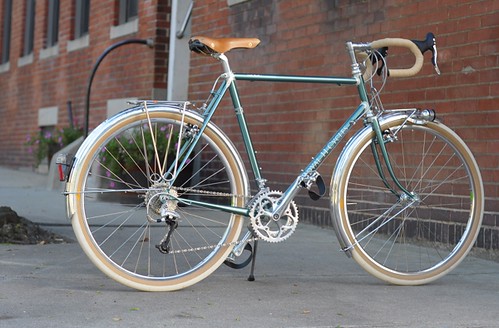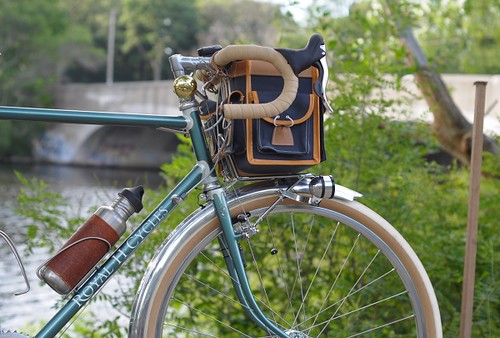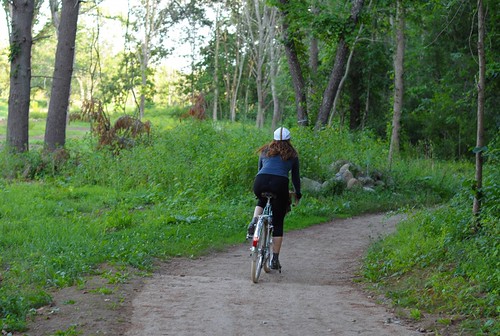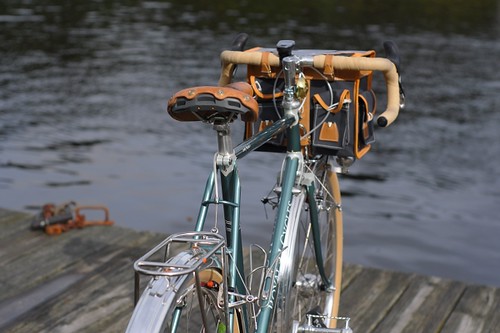 Throughout the Spring and Summer of , I collaborated with Royal H. Cycles to create a classic low-trail 650B randonneuring bicycle, then test rode it for 220 miles before it was delivered to the new owner. The project was inspired by Jan Heine, whose championing of this type of bicycle made some of us rabid with curiosity. This review has been long in the works. In parallel I've been preparing an article about the same bike for the Bicycle Quarterly, and needed to make sure that its content did not overlap too much with this write-up. Now that the BQ article is finally finished, I feel that the project is complete and would like to reflect upon it here.
Throughout the Spring and Summer of , I collaborated with Royal H. Cycles to create a classic low-trail 650B randonneuring bicycle, then test rode it for 220 miles before it was delivered to the new owner. The project was inspired by Jan Heine, whose championing of this type of bicycle made some of us rabid with curiosity. This review has been long in the works. In parallel I've been preparing an article about the same bike for the Bicycle Quarterly, and needed to make sure that its content did not overlap too much with this write-up. Now that the BQ article is finally finished, I feel that the project is complete and would like to reflect upon it here.If this is the first you are reading about this bike, then you may want to start here before proceeding:
.Making Sense of Rivendell's vs Bicycle Quarterly's Philosophies
.A Beautiful Experiment
.Lovely Bicycle x Royal H Randonneur
.650B Rivendell Sam Hillborne and Randonneur Compared
The posts above describe how the idea for the bike came about, as well as its construction and features, so I will not cover the same ground again here. At some point in the near future I will also write more aboutthe project itself - what it was like to work together with a framebuilder and what I learned in the process. But here I will describe my impressions of the bicycle itself - particularly the aspects that were novel to me. Of course being involved in the bicycle's design, it would be somewhat absurd to either praise or critique its aesthetics and such. The point of this experiment was to form an impression of how this type of bicycle handles, and that is what I will focus on here.

The Low Trail Mystique
To briefly summarise, the Randonneur is a lugged steel low-trail bicycle with 650Bx42mm tires, fenders, dynamo lighting, front and rear racks, and a handlebar bag - made in the style of the 20th century French constructeurs. "Low-trail" refers to the front-end geometry of a bicycle and it differs from the typical mid/high trail geometry of most roadbikes today. Among classic and vintage bicycle enthusiasts, there is definitely a mystique surrounding the low trail randonneur, and dramatic descriptions of its handling abound - made all the more dramatic, I suspect, by the fact that this type of bicycle is fairly rare and few have actually ridden it. Certainly that was one of the factors that made me want to try it. The other factor was that Jan Heine's description of the bicycle suggested a combination of speed, responsiveness, comfort, and all-terrain capability that I found attractive.
The biggest surprise about the Randonneur once I began to ride it, was how "normal" it felt. Based on all of the things I had heard and read about low-trail handling by the time the bike was ready, I expected to be blown away by a radically different handling, which I would either love or hate. Instead, the bike felt... like a bike! When I mentioned this earlier, some interpreted it as my implying that I was disappointed with the Randonneur. However that is not what I meant to express at all. I simply meant that I did not find low trail handling to be "difficult" or unusual. While the Randonneur did have some interesting handling characteristics, it felt intuitive to ride and I think that my experience of this is important to communicate. It seems to me that the mystique surrounding low-trail geometry needlessly intimidates people.
 So what did feel different about the low trail handling, even if I found it within the range of normal? Mainly, it was the way the bicycle behaved on turns. At slow speeds I found that I had to be slightly more active when turning than on other road bikes I'd ridden, to pay more attention to the act of turning if that makes sense. Interestingly, this made tight turns easier as opposed to more difficult: I felt as if I were more in control of the turn. I also noticed that on high speed descents along winding roads it was easier to keep my line of travel along the road's curvature; the Randonneur did not "resist" turning at high speeds as I sometimes feel typical roadbikes do. That said, all of this was rather subtle - at no point did this difference alarm or shock me. I would notice the unique behavior on turns and think "Oh neat, so it wants to do this and not that" - as opposed to feeling as if there was anything wrong. It's a different feeling is all, and I rather liked it.
So what did feel different about the low trail handling, even if I found it within the range of normal? Mainly, it was the way the bicycle behaved on turns. At slow speeds I found that I had to be slightly more active when turning than on other road bikes I'd ridden, to pay more attention to the act of turning if that makes sense. Interestingly, this made tight turns easier as opposed to more difficult: I felt as if I were more in control of the turn. I also noticed that on high speed descents along winding roads it was easier to keep my line of travel along the road's curvature; the Randonneur did not "resist" turning at high speeds as I sometimes feel typical roadbikes do. That said, all of this was rather subtle - at no point did this difference alarm or shock me. I would notice the unique behavior on turns and think "Oh neat, so it wants to do this and not that" - as opposed to feeling as if there was anything wrong. It's a different feeling is all, and I rather liked it.Another outcome of low trail (though this is not about handling per se) is that it allows even small bicycles with fat tires and fenders to avoid toe overlap without the need for an overly long top tube. For me this is a huge deal, because I strongly dislike toe overlap and I ride small bikes. The fact that low-trail geometry automatically eliminates it as a concern is very appealing.
While yet another aspect of the low trail design is said to be its superior ability to handle a front load, in this respect my experience is unhelpful. I rode the bicycle with and without the medium Berthoud handlebar bag pictured here, and did not notice a significant difference. It felt fine with the bag. It felt fine without. Perhaps this lack of a difference is the point - meaning, you can add a full handlebar bag and the handling remains the same. However, some believe that a low-trail bike is meant to be ridden with a loaded bag at all times and will feel unstable without it. This I did not experience.

Best of Both Worlds?
The Bicycle Quarterly's descriptions of randonneuring bicycles suggest that they are essentially fully equipped, comfortable racers - thus offering the best aspects of touring bikes and racing bikes combined.
For me, the speed of the Randonneur was not quite on par with that of a racing bike (namely, the Seven Axiom I'd tried over the summer). However, the Randonneur was faster than my Sam Hillborne.It was also faster than various vintage roadbikes I've tried.
 The weight of the complete bicycle (including bottle cages, MKS Touring pedals and handlebar bag) was around 26lb (for comparison, my Sam Hillborneis 31lb with a similar setup), which is fairly light given all the stuff it is outfitted with, but not racing bike territory. The standard diameter tubing made it easier for me to carry the bike (my hand could close around the top tube, whereas with oversized tubing it cannot), which was much appreciated.
The weight of the complete bicycle (including bottle cages, MKS Touring pedals and handlebar bag) was around 26lb (for comparison, my Sam Hillborneis 31lb with a similar setup), which is fairly light given all the stuff it is outfitted with, but not racing bike territory. The standard diameter tubing made it easier for me to carry the bike (my hand could close around the top tube, whereas with oversized tubing it cannot), which was much appreciated.As far as comfort, the Randonneur was the feather bed of bicycles. While I have no complaints at all about the comfort of my Rivendell, the Randonneur felt even better, as well as less fatiguing at the end of a ride. In part this may be due to the flexible, standard diameter tubing. Of course given this lightweight and flexible tubing, bicycles like the Randonneur are not suitable for carrying as much weight as touring bikes.

Notes on Components
I won't go over all of the components this bicycle is fitted with, but would like to highlight the ones that were new to me or made an impression.
As mentioned earlier, I loved the Grand BoisMaes handlebars with their flat ramps and parallel drops. I am addicted to Campagnolo ergo levers at this point, and the Veloce model here (also on my Rivendell) is an economical option that works perfectly well for me. I prefer the Schmidt SON dynamo hub on this bicycle to the Shimano hub on my own bike, and the Edelux headlight is the nicest dynamo light I have tried thus far. The Grand Bois Hetre tires I love so much - both on the Randonneur and on my Rivendell - that I cannot imagine not owning a bike fitted with them. I was impressed with the Nitto lugged stem, truly a work of art. The Berthoud handlebar bag intimidated me somewhat with its beautiful styling, but the multiple sizes it comes in might make it a more convenient alternative to the enormous Ostrich handlebar bag I have on my own bike.
 In the process of riding this bike I also discovered that I prefer the men's Berthoud touring saddle to the women's. I never wear skirts on roadbikes anyhow, and the longer nose and slightly narrower saddle feels even better here than the shorter, wider version on my own bike.
In the process of riding this bike I also discovered that I prefer the men's Berthoud touring saddle to the women's. I never wear skirts on roadbikes anyhow, and the longer nose and slightly narrower saddle feels even better here than the shorter, wider version on my own bike.I am not certain what I think of cantilever brakes - not just on this bicycle, but in general. On fast descents, both the Randonneur and my own canti Rivendell are rather effortful for me to stop. These brakes are supposed to be very powerful and are the classic brakes to use with this style of bicycle, so I am not sure what the alternatives are. That said, almost everyone I know loves cantis, so I might just be an anomaly (I do have very weak hands).
If I were speccing out this bicycle from scratch today, the one change I would make would be to go with the new Rene Herse crankset (which was not yet available last summer). This would be a more aesthetically appropriate (albeit much pricier) option than the Sugino Alpina crankset we used, and its gearing versatility would have allowed us to use a short-cage rear derailleur for an overall more classic look to the drivetrain. None of this however would change the bike's functionality.
I was quite happy with how the Randonneur worked as a whole, including components and accessories. Nothing rattled loose or malfunctioned in the course of my test rides, which included road and gravel.

Verdict
Based on my experience with the Randonneur, my impression is that this type of bicycle combines some of the best features of road-racing bikes and all-terrain touring bikes, but does not replace either. If I owned this bicycle, I would still want a pure road-racing bike in addition. And for those interested in fully loaded touring, the Randonneur would not be the right choice for carrying that much weight. But for self-supported long distance events, endurance events, recreational and nature rides, and anything involving off-road trails and mixed terrain I believe this would be just the ticket - both for competitive cycling and for pleasure. The standard diameter tubing, wide 650B tires, fast and responsive handling, fenders, lights and moderate luggage make it an option worth considering for those who feel that touring bikes are overbuilt for them, while road/racing bikes are unsuitable for real-world conditions. In my view, the low trail geometry is not nearly as quirky as some suggest, and has the additional benefit of avoiding the dreaded toe overlap.
A question I've been asked a number of times now over email, is whether I plan to get a bicycle like this made for myself and whether I would recommend it to others. The first part of this question is tough to answer, because if I did get a bicycle like this then it would replace my Rivendell - I neither need nor can afford to own two 650B road-to-trail bikes! So I just don't know yet whether I want to go through that upheaval. That said, I do think that a bicycle like the Randonneur is extremely appropriate for my style of riding, for all the reasons described in this review. If I did decide to replace my Rivendell with a lighter and faster bike with the same wide tires and handlebar bag, something like this would be it. As for recommending it to others, I don't even dare go there. We are all so different, and only you can decide whether a bicycle like this is suitable for your needs.

Afterthoughts...
An important aside here, is that when designing a bicycle like this, geometry and tubing choice are crucial. If you decide to have a classic low-trail randonneuringframe built, be sure the builder fully understands your request. It is popular now to refer to all bicycles fitted with fenders, racks, and tires wider than 23mm as "rando bikes," but the bicycle I describe here is a very particular animal and the builder needs to understand that - unless of course you can supply them with the full geometry and specifications. There is now also a number of ready-made randonneuringframes (though none of them fully lugged, as far as I understand) that may be suitable for those reluctant to go custom, including the Box Dog Pelican and the Rawland RSogn.
The length of this review makes me realise just how much information I have stored up about this bicycle. Stay tuned for the write-up about the project itself - including commentary on the framebuilder's work, detailed descriptions of the geometry and all that. And for those interested in the Bicycle Quarterly article (which will contain different content still), look for the Spring issue.
My sincere thanks to everyone involved in this project: Bryan of Royal H. Cycles, Jim A. of Harris Cyclery, and Jim P. the bicycle's owner - as well as to Jan of the Bicycle Quarterly for the inspiration and advice. More pictures here and here!
No comments:
Post a Comment